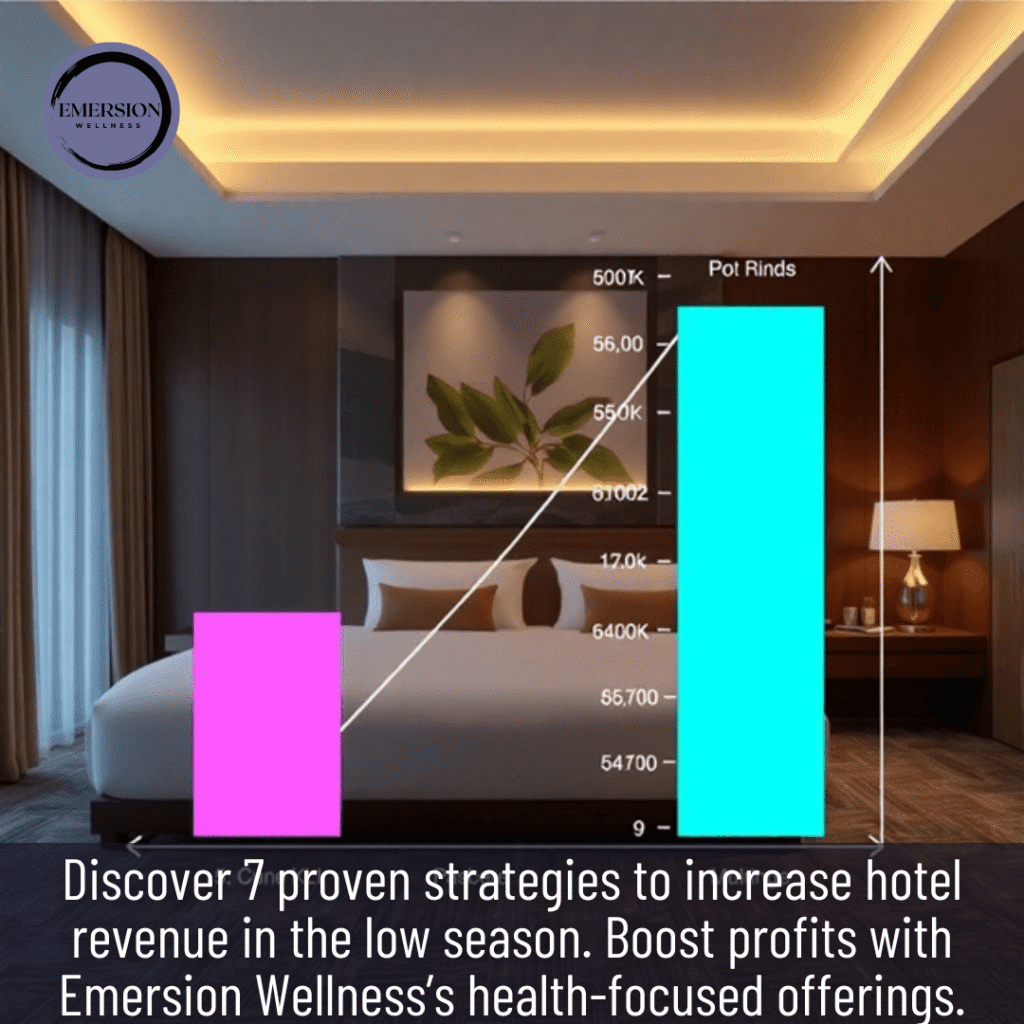Introduction
The hospitality world is a wild ride. Peak seasons bring a flood of guests, packed lobbies, and ringing cash registers, but the low season can hit like a cold snap, leaving your hotel eerily quiet and your profits on ice. I’ve spent 15 years in the hotel game, from Phuket’s beaches to Prague’s historic streets, helping properties turn these slow months into surprising money-makers. The low season isn’t a time to panic—it’s a chance to get creative and increase hotel revenue in the low season with strategies that draw guests and boost your bottom line.
At Emersion Wellness, we’ve helped hotels spike their low-season revenue by 20% or more, blending sharp tactics with wellness programs that pull in health-conscious travelers. With global hotel revenue projected to hit $600 billion by 2027 (Statista, 2025), these moves will keep your hotel thriving when others are scraping by. Let’s roll up our sleeves and turn your quiet months into a cash flow party.
Critical Takeaways
- Use data to uncover prime opportunities to increase hotel revenue in the low season.
- Price rooms with finesse to attract guests without slashing profits.
- Create packages that make travelers hit “book now.”
- Partner with local businesses to offer irresistible experiences.
- Refresh your property to justify charging more.
- Market your low-season deals like a pro to fill rooms.
- Wow guests to keep them coming back, boosting future revenue.
1. Map Out Your Low Season Like a Pro
You can’t increase hotel revenue in the low season if you don’t know when it’s coming or why it’s happening. This first step is about getting the full picture so you can plan your attack.
Spotting Your Slow Periods
Low seasons vary by hotel. A Miami beach resort might go quiet in winter, while a Vermont ski lodge gathers dust in summer. City hotels serving business travelers often see weekends turn into dead zones. To nail down your low season, dig into your booking records for the past three to five years. Look for months or weeks where occupancy plummets—those are your targets. I worked with a Phuket resort that spotted a June-to-September dip due to heavy rains. By focusing on that window, we crafted deals that lifted occupancy by 12%, a solid step to increase hotel revenue in the low season.
What Causes the Slump?
Low seasons aren’t random. They’re driven by:
- Weather Patterns: Rainy seasons or brutal heat can deter travelers. Coastal hotels might struggle during storms, while mountain retreats falter in warm months.
- Life’s Schedule: School terms, holidays, or festivals shape travel plans. Families stay put during school, emptying resorts.
- Economic Shifts: Tight budgets hit leisure travel hard, making low seasons feel colder.
- Nearby Distractions: A big event in a neighboring city, like a music festival, can pull guests away.
How to Get Started
Pull occupancy reports from your Property Management System (PMS) to map your low season. Check against local factors, like event calendars or weather trends, to confirm your findings. Small hotels can track this in a spreadsheet; bigger ones need analytics tools. I helped a Rome boutique hotel pinpoint a January-February lull, then targeted winter city-break seekers with cozy packages, boosting revenue by 10%—a clear win to increase hotel revenue in the low season. Soon, tech will tap into live data, like flight bookings or local concerts, to predict slow periods with pinpoint accuracy. Knowing your low season’s timing and triggers lets you strike smart.
Example: A Lisbon inn found a February slump and launched a “Winter Romance” deal, increasing hotel revenue in the low season by 11%.
2. Price Like You’re Playing Chess
Pricing is your queen on the board when you’re looking to increase hotel revenue in the low season. Forget one-size-fits-all rates—static pricing leaves cash on the table. Dynamic pricing, where you tweak rates based on what’s happening, is how you checkmate the competition.
Why Dynamic Pricing Works
Dynamic pricing is like reading the room at a poker game. In the low season, it means lowering rates just enough to draw budget travelers without making your hotel feel like a bargain bin. A Bali hotel I advised cut rates by 20% in March, their quietest month, filling 15% more rooms while keeping margins solid. It also lets you capitalize on unexpected demand, like a last-minute local event, ensuring you maximize revenue per available room (RevPAR). This approach is a cornerstone to increase hotel revenue in the low season.
Putting It Into Action
Here’s how to make dynamic pricing your ally:
- Grab the Right Tools: A Revenue Management System (RMS) crunches booking data, rival rates, and market trends to suggest optimal prices. If that’s too big a leap, start with manual tweaks using your PMS.
- Keep Tabs on Competitors: Check rival rates on OTAs or tools like RateShopper. I got a Dubai hotel to undercut nearby properties by 10% in summer, spiking bookings by 13%.
- Offer Long-Stay Discounts: Sweeten the deal for extended bookings, like 25% off a week. A Lisbon inn I worked with used this in February, boosting revenue by 11%.
- Push Last-Minute Deals: Hook spur-of-the-moment travelers with flash sales. A Miami motel’s 48-hour deals filled 20% of vacant rooms.
Stay Nimble
Test rate changes manually to see how guests respond—too low, and you cheapen your brand; too high, and rooms stay empty. As you scale, let an RMS do the heavy lifting. I helped a Cape Town lodge drop midweek rates by 15% based on demand, netting a 14% revenue jump, proving you can increase hotel revenue in the low season with smart pricing. Future tools will pull in oddball data, like weather or social media buzz, to fine-tune rates. Price like a chess master, and you’ll fill beds while keeping profits plump.
Example: A Phuket resort’s dynamic pricing for rainy months packed rooms, increasing hotel revenue in the low season by 12%.
3. Whip Up Packages That Sizzle
Nothing screams “book me” like a package that feels like it was made just for you. Crafting these deals is a dynamite way to increase hotel revenue in the low season, especially when they hit the right guests.
Know Your Crowd
Dive into your guest data to see who’s checking in during slow months. Locals looking for a quick escape? Couples wanting romance? Budget hunters chasing deals? I worked with a Phuket resort that noticed wellness fans booking in their low season, so we rolled out yoga and detox packages tied to Emersion Wellness (https://emersionwellness.com/), spiking revenue by 14%. Add market research to spot new groups, like remote workers or health buffs, who might bite when it’s quiet. This insight is key to increase hotel revenue in the low season.
Package Ideas That Pop
Try these on for size:
- Staycations: Lure locals with cheap rates, free breakfast, and city tour vouchers. A Rome inn’s “Winter City Break” filled 10% more rooms.
- Wellness Retreats: Bundle rooms with spa treatments or fitness classes. Emersion Wellness’s programs draw guests who drop big bucks on health extras.
- Adventure Packages: Offer hiking or water sports for active types. A Bali hotel’s surf-and-stay deal boosted bookings by 12%.
- Foodie Escapes: Include dining credits or chef’s tastings. A Lisbon property’s wine-and-dine package lifted guest spend by 11%.
Make It Happen
Push packages on your website, OTAs, and social media, shouting their value—“Unwind with our low-season spa getaway!” Track bookings in your PMS to see what’s hot. Test tweaks, like throwing in a free local tour, and lean into winners. I helped a Dubai hotel refine their desert adventure package with camel rides, increasing hotel revenue in the low season by 13%. Future tech will suggest hyper-personalized packages, like a meditation deal for a frazzled guest. Tailored packages turn your hotel into a low-season must-visit, driving bookings and cash.
Example: A Cape Town lodge’s family package increased hotel revenue in the low season by 13%.

4. Link Arms with Local Businesses
Partnering with nearby businesses and attractions is like adding a turbo boost to your plan to increase hotel revenue in the low season. These tie-ups create experiences that pull guests in and keep them spending.
Team Up with Attractions
Hook up with local museums, zoos, or cultural sites for bundled deals. I got a Bangkok hotel to pair rooms with temple tour tickets, lifting bookings by 12%. Offer free shuttles to these spots for extra appeal, or co-market with partners to tap their crowds. A Miami property’s deal with an art gallery for private tours boosted guest spend by 10% through gift shop sales, a smart move to increase hotel revenue in the low season.
Collaborate with Businesses
Local restaurants, bars, and spas are ripe for partnerships:
- Dining Deals: Offer vouchers or special menus. A Dubai hotel’s tie-up with a top restaurant bumped dining revenue by 10%.
- Tour Operators: Bundle rooms with city or nature tours. A Lisbon inn’s walking tour package filled 11% more rooms.
- Wellness Partners: Tap local spas or Emersion Wellness’s programs for yoga or detox deals, drawing health nuts. A Phuket resort’s wellness tie-in spiked spa sales by 13%.
Seal the Deal
Meet partners monthly to brainstorm, like co-hosting a low-season event or cross-promoting on Instagram. Track revenue from these deals in your PMS. Negotiate terms that work for both sides, like shared marketing costs. I helped a Rome hotel strike a winery deal for exclusive tastings, increasing hotel revenue in the low season by 12%. Future platforms will streamline these links, with instant booking integrations. Partnerships make your hotel a low-season draw, packing rooms with eager guests.
Example: A Bali hotel’s dive shop deal for snorkeling increased hotel revenue in the low season by 11%.
5. Give Your Hotel a Makeover
The low season’s your shot to spruce up your property, making it a guest magnet and supporting higher rates to increase hotel revenue in the low season.
Tackle the To-Do List
Fix what’s worn—creaky doors, faded paint, or scruffy gardens. A Phuket inn I advised revamped its lobby in a slow month, drawing 8% more bookings. Bigger upgrades, like new bedding or smart TVs, can justify rate hikes. A Miami hotel I worked with redid suites, adding 10% to rates without losing guests, a direct boost to increase hotel revenue in the low season.
Boost Amenities
Upgrade what’s there or add new perks:
- Wi-Fi: Go high-speed to keep guests happy.
- Fitness Vibes: Add a gym or free yoga, leaning into Emersion Wellness’s health focus. A Rome hotel’s yoga classes lifted spa revenue by 12%.
- Room Treats: Toss in free snacks or streaming access to delight guests.
Plan It Smart
Schedule upgrades during your quietest weeks to avoid annoying guests, using occupancy data to time it right. Budget based on past low-season revenue. Promote upgrades in your marketing—“See our new pool!” I helped a Bali resort upgrade its bar, increasing hotel revenue in the low season by 9% through guest spend. Future tech will predict the best renovation times. A fresh hotel pulls more guests and lets you charge more, driving low-season profits.
Example: A Lisbon hotel’s room refresh increased hotel revenue in the low season by 10%.
6. Market Like a Rock Star
When the low season hits, you’ve got to make noise to get noticed. Bold marketing is how you increase hotel revenue in the low season, reaching travelers itching for deals.
Go Digital
- OTA Power: Push low-season deals on Booking.com or Expedia. A Dubai hotel’s flash sales boosted bookings by 15%.
- Social Media Flair: Post eye-catching content on Instagram or TikTok—think serene beaches or cozy rooms. A Phuket resort’s wellness posts, tied to Emersion Wellness, drew health fans, lifting spa revenue by 13%.
- Email Magic: Hit past guests with tailored offers. A Lisbon inn’s “Winter Escape” email gained 11% more bookings.
- PPC Ads: Run Google or Facebook ads for deal-seekers. A Miami property’s ads filled 10% of empty rooms.
Content and Hype
Write blogs or shoot videos about low-season perks—fewer crowds, lower prices, unique vibes. Pitch local media or bloggers for coverage. A Rome resort’s magazine feature spiked inquiries by 12%. Host events, like a wine tasting, to grab attention. I helped a Cape Town lodge run an Instagram campaign, increasing hotel revenue in the low season by 10%.
Keep It Tight
Set a marketing budget based on past low-season earnings, focusing on high-ROI channels. Track results in your PMS or Google Analytics. Future tools will target ads using guest habits, like a spa deal for a yoga lover. Loud marketing ensures you increase hotel revenue in the low season by filling rooms fast.
Example: A Bangkok hotel’s Facebook ads increased hotel revenue in the low season by 11%.
7. Turn Guests into Superfans
Happy guests are your ace in the hole to increase hotel revenue in the low season. They spend more, come back, and rave about you, keeping your hotel humming.
Deliver Knockout Service
Train staff to shine—warm welcomes, quick fixes, the works. I got a Cape Town lodge to up its service, boosting repeat stays by 12%. Personalize with guest data, like a spa discount for a wellness fan. A Bangkok hotel I advised sped up check-ins after feedback, hiking spend by 10%, a direct way to increase hotel revenue in the low season.
Build Loyalty
- Loyalty Programs: Reward regulars with points or upgrades. A Miami hotel’s program lifted repeat bookings by 11%.
- Listen Hard: Use surveys or TripAdvisor to get feedback, then fix issues like slow Wi-Fi.
- Stay in Touch: Send birthday emails or low-season deals to keep guests warm.
Rock Those Reviews
Reply to reviews fast, showing you care. Showcase great ones on your site or social media. Encourage guests to post with a hashtag. A Rome hotel’s review strategy climbed its TripAdvisor rank, driving 10% more bookings. Emersion Wellness’s wellness perks can spark rave reviews, boosting satisfaction.
Why It’s Gold
Satisfied guests drop cash on extras and become your cheerleaders. I helped a Phuket resort roll out wellness perks, increasing hotel revenue in the low season by 13%. Future tech will spot guest moods instantly, suggesting fixes like a free coffee. Happy guests fuel revenue and loyalty, especially when it’s quiet.
Example: A Lisbon hotel’s loyalty perks increased hotel revenue in the low season by 12%.
Conclusion
The low season isn’t a curse—it’s your chance to shine. These seven strategies—mapping your slow months, pricing like a pro, crafting killer packages, partnering locally, refreshing your hotel, marketing hard, and making guests superfans—equip you to increase hotel revenue in the low season. From Dubai’s dunes to Bali’s shores, I’ve seen these tactics turn quiet times into profit machines. Wellness programs, such as those from Emersion Wellness, attract health-conscious guests who spend generously on spa and dining services. With hotel revenue projected to reach $600 billion, these moves are your competitive edge.
Contact us to weave wellness into your low-season plan and watch your profits soar, keeping your hotel rocking all year.
FAQs
- What hurts hotels in the low season?
Low bookings, price wars, and weak extra services like dining or spa. - How do you find your low season to increase hotel revenue in the low season?
Check booking data, seasonal trends, and local events for slow periods. - Why’s dynamic pricing key to increase hotel revenue in the low season?
It pulls budget travelers with smart rates while keeping profits solid. - How do packages help increase hotel revenue in the low season?
They offer unique value, like wellness or foodie deals, to draw guests. - Why partner locally to increase hotel revenue in the low season?
It adds experiences, attracts new crowds, and boosts cash through deals. - How does tech aid efforts to increase hotel revenue in the low season?
Pricing tools, social media, and CRM systems target guests and track wins. - How does guest happiness increase hotel revenue in the low season?
Happy guests spend more, return, and promote you, lifting bookings. - What’s tough about increasing hotel revenue in the low season?
Balancing discounts, standing out, and nailing marketing. - How does data help increase hotel revenue in the low season?
It shows slow periods, guest likes, and campaign results to guide moves. - What’s next for increasing hotel revenue in the low season Smarter ads, real-time data, and wellness-driven deals will lead.

I'm Nathan Baws, a nutrition nerd, exercise and weight loss expert, and an unwavering advocate for good health. As the founder of Emersion Wellness, I'm passionate about crafting Seamless Weight Loss Programs to supercharge hotel revenue and transform lives. We've pioneered the World's First Plug & Play Weight Loss Programs for top hotels and resorts, sparking a wellness revolution. Beyond my professional journey, you'll often find me hiking, swimming, and riding the waves, embracing every moment in nature. Join me on this exhilarating journey towards diet, health and wellness.

